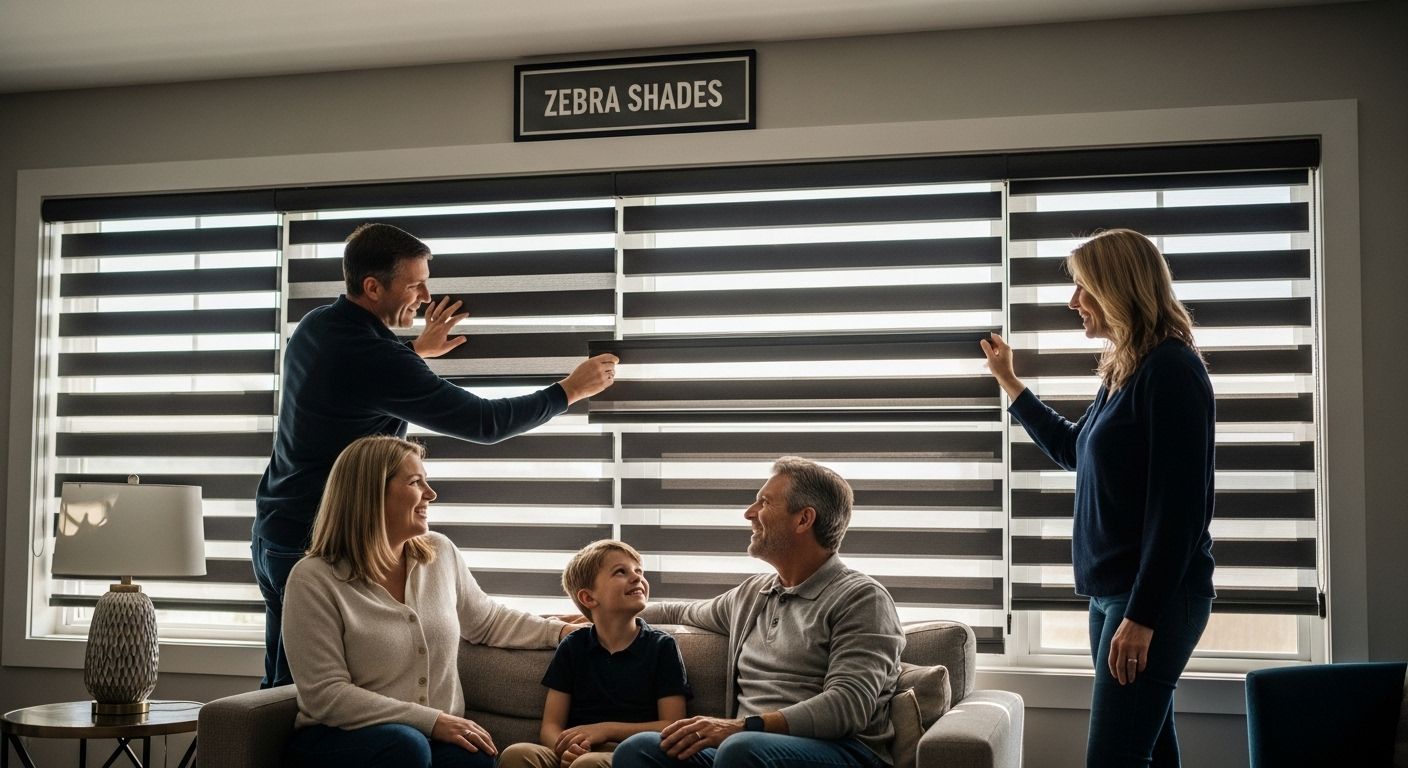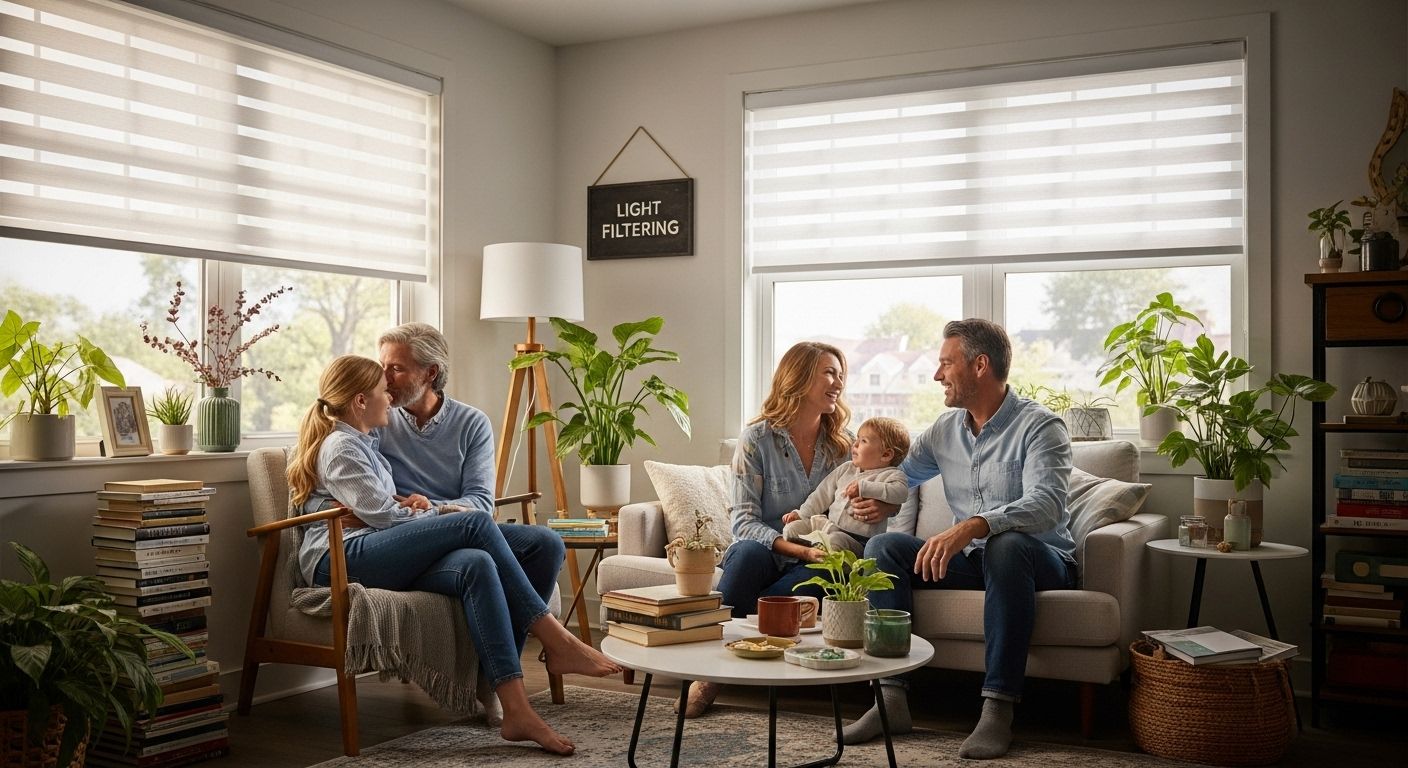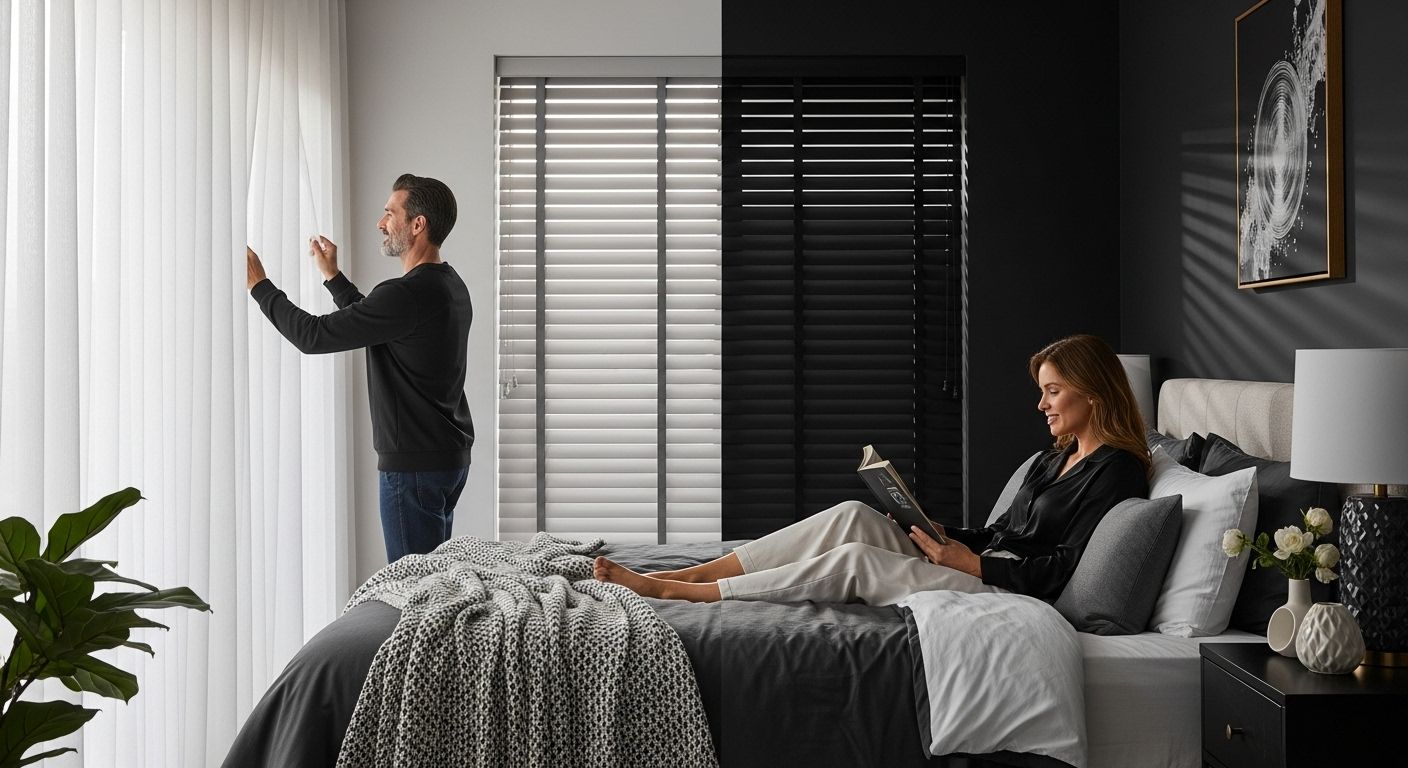
7 Best Blinds for Bedrooms: Enhance Sleep & Style
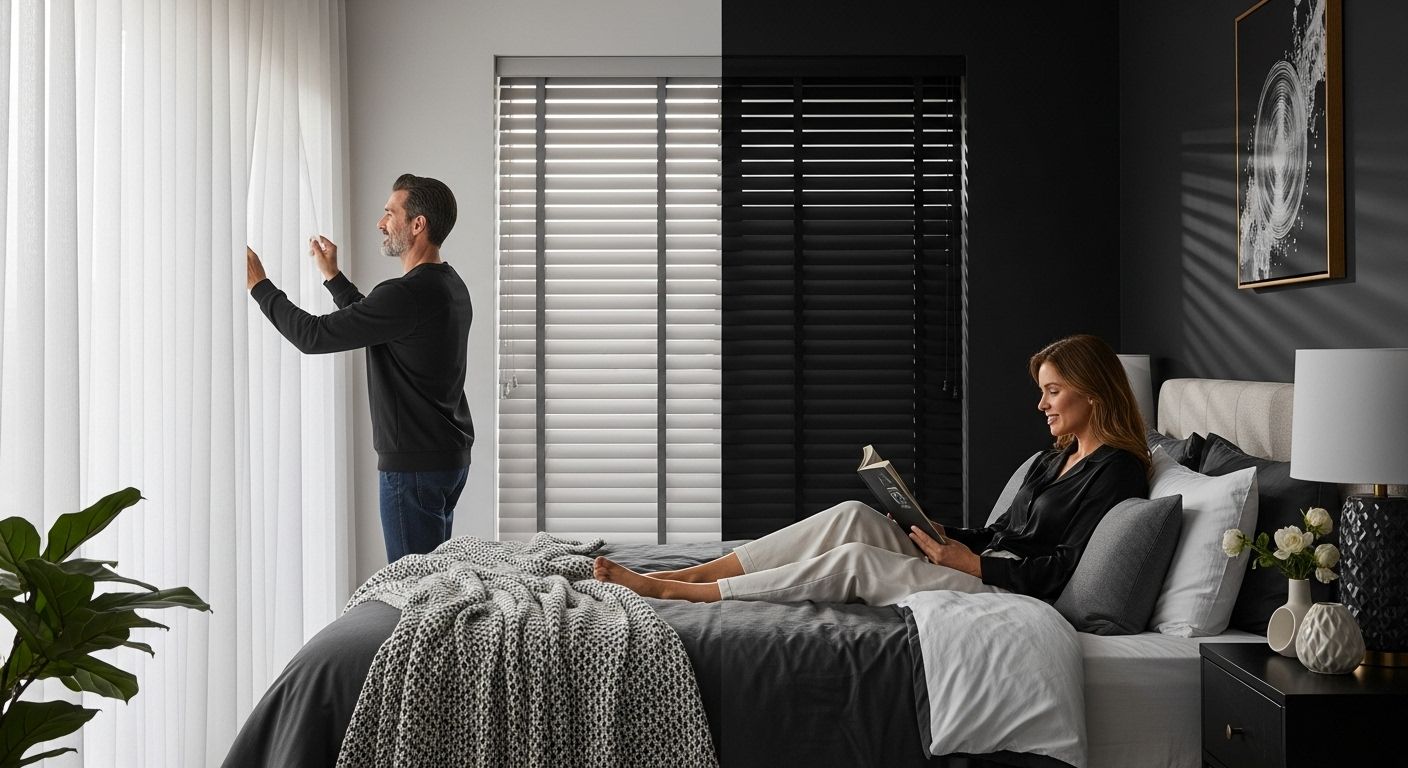
Picking out bedroom blinds is about more than just picking a style you like. Research shows that nighttime light exposure can actually cut your melatonin levels and throw your sleep off track by disrupting your natural rhythms. Most people think blinds are only about looks or adding privacy. The real surprise is how much your choice can impact your health and daily comfort with a single decision.
Table of Contents
- Understand Your Bedroom Lighting Needs
- Explore Different Types of Blinds
- Consider Energy Efficiency Features
- Choose the Right Material for Your Blinds
- Match Blinds with Bedroom Decor Style
- Prioritize Ease of Use and Maintenance
- Measure Your Windows Correctly for Optimal Fit
Quick Summary
| Takeaway | Explanation |
|---|---|
| Prioritize light management for sleep quality. | Select blinds that block light to create a restful sleeping environment, positively impacting your health and sleep duration. |
| Choose blinds based on your room’s orientation. | Evaluate how natural light enters your bedroom to determine the best type of blinds for effective light control and comfort. |
| Opt for energy-efficient blind designs. | Look for window treatments with thermal insulation and light reflection capabilities to regulate indoor temperatures and reduce energy costs. |
| Select materials that enhance comfort and aesthetics. | Consider durability, maintenance, and allergen resistance while choosing materials that fit both style and functionality in your bedroom. |
| Accurate measurements are crucial for installation. | Ensure precise window measurements for effective blind fitting, which contributes to both aesthetic appeal and optimal performance. |
1: Understand Your Bedroom Lighting Needs
Choosing the right blinds for your bedroom goes far beyond aesthetic appeal. Light management is crucial for creating an optimal sleep environment and directly impacts your overall health and well being. According to research published in the journal Clocks & Sleep, nighttime light exposure can dramatically suppress melatonin production, disrupting your natural sleep cycles.
When selecting bedroom blinds, consider these critical factors:
-
Light blocking capability: Essential for creating a dark, restful sleeping environment
-
Privacy requirements: Ensuring complete visual protection from outside view
-
Room orientation and sunlight exposure: Understanding how natural light enters your specific space
Your bedroom’s unique characteristics play a significant role in determining the most suitable window treatments. Factors like window size, room layout, and personal sleep preferences will guide your blind selection process. Some rooms might require total blackout capabilities, while others need more nuanced light filtering.
Most individuals underestimate the profound connection between light control and sleep quality. Proper light management can improve sleep duration, reduce nighttime awakenings, and support healthier circadian rhythms. This means selecting blinds isn’t just about decoration—it’s about creating a scientifically optimized sleep sanctuary.
Consider our expert guide on custom window treatments to dive deeper into personalized solutions that match your specific bedroom lighting needs.
2: Explore Different Types of Blinds
Blind selection for bedrooms requires understanding the unique characteristics of different window treatments. Each type offers distinct advantages for light control, privacy, and aesthetic appeal. According to the U.S. Department of Energy, various blind styles provide different performance metrics that can significantly impact your bedroom environment.
Key blind types for bedroom spaces include:
-
Venetian Blinds: Horizontal slats offering precise light control and classic styling
-
Roller Blinds: Sleek, minimalist design with excellent light blocking capabilities
-
Cellular Shades: Superior insulation and energy efficiency for temperature regulation
Horizontal blinds like venetian styles provide granular light adjustment through tilting mechanisms. They allow you to create soft ambient lighting or complete darkness with simple angle modifications. Vertical blinds work exceptionally well for larger windows or sliding glass doors, offering smooth operation and comprehensive coverage.
Roller blinds represent a modern solution for bedrooms seeking clean lines and maximum light blocking. Blackout roller blinds can transform your bedroom into a perfect sleep sanctuary, eliminating external light sources that might disrupt your rest. Their simple mechanism and compact design make them ideal for contemporary interior spaces.
Cellular shades bring an additional layer of functionality. Their honeycomb structure traps air, providing thermal insulation that helps maintain consistent bedroom temperatures. This design reduces heat transfer, potentially lowering energy costs while creating a comfortable sleeping environment.
Discover more about selecting the perfect window treatments to match your specific bedroom needs and aesthetic preferences.
3: Consider Energy Efficiency Features
Energy efficiency is not just an environmental consideration—it directly impacts your comfort and utility costs. Window treatments play a significant role in regulating indoor temperatures and reducing energy consumption. According to Oak Ridge National Laboratory researchers, specific blind designs can dramatically improve home energy performance.
When evaluating energy efficient blinds, focus on these critical features:
-
Thermal insulation capabilities: Ability to minimize heat transfer
-
Material composition: Impact on overall energy conservation
-
Light reflection and absorption properties: Influence on room temperature
Cellular shades emerge as top performers in energy management. Their unique honeycomb structure creates air pockets that act as thermal barriers, significantly reducing heat loss during winter and heat gain during summer. This design helps maintain consistent indoor temperatures while minimizing reliance on heating and cooling systems.
Window blind materials also contribute substantially to energy efficiency. Cellular and thermal curtain blinds made from specialized fabrics can reflect solar radiation, preventing excessive heat absorption. Dark colored blinds absorb more heat, while lighter colors reflect sunlight, helping you manage indoor temperature more effectively.
Additionally, consider blinds with advanced technological features like smart sensors that automatically adjust based on sunlight intensity and room temperature. These intelligent systems optimize energy consumption by responding dynamically to environmental changes.
Learn more about maximizing your home’s energy performance through strategic window treatment selections.
4: Choose the Right Material for Your Blinds
Selecting the right blind material is crucial for creating a sleep-friendly environment and maintaining long-term aesthetic appeal. According to research published in the Journal of Clinical Sleep Medicine, the type of window covering significantly impacts sleep quality and overall bedroom comfort.
Key material considerations for bedroom blinds include:
-
Durability: Resistance to wear and tear
-
Light blocking capabilities: Effectiveness in creating darkness
-
Moisture and temperature resistance: Performance in varying environmental conditions
Wooden blinds offer a classic, timeless aesthetic with excellent insulation properties. They provide natural temperature regulation and can be crafted with blackout capabilities, making them ideal for bedrooms seeking both style and functionality. However, they require more maintenance compared to synthetic materials.
Fabric-based materials like cellular shades present a modern alternative. Their soft texture and advanced light-filtering technologies create a gentle, sophisticated look while providing superior energy efficiency. Synthetic materials such as polyester and vinyl offer enhanced durability and are easier to clean, making them practical for households with children or pets.
For those prioritizing health, consider materials that minimize potential allergen accumulation. Smooth, non-porous surfaces like aluminum or treated synthetic fabrics reduce dust and mite collection, contributing to a cleaner sleeping environment.
Explore sustainable window treatment options that balance environmental consciousness with exceptional bedroom performance.
5: Match Blinds with Bedroom Decor Style
Creating a harmonious bedroom aesthetic requires thoughtful selection of window treatments that complement your existing design. According to research from Virginia Tech, window configurations significantly influence interior design choices and overall room perception.
Consider these key design alignment strategies:
-
Color coordination: Selecting blind colors that enhance existing room palette
-
Texture matching: Complementing furniture and textile materials
-
Style consistency: Ensuring blinds reflect room’s overall design theme
Modern minimalist bedrooms benefit from sleek roller blinds with clean lines and neutral colors. These treatments provide a streamlined look that doesn’t compete with contemporary furniture. For traditional spaces, wooden venetian blinds offer warmth and classic elegance, creating a sophisticated backdrop that integrates seamlessly with ornate or vintage furnishings.
Color selection goes beyond aesthetic appeal. Psychological research demonstrates that interior colors profoundly impact emotional well-being. Soft, muted blind colors can create a calming environment, while deeper tones might add dramatic depth to your bedroom design.
Consider your room’s existing elements when choosing blind styles. Rooms with bold artwork or statement furniture might require more understated window treatments, while minimalist spaces can accommodate more intricate or textured blind designs.
Discover personalized window treatment strategies that transform your bedroom into a cohesive, stylish sanctuary.
6: Prioritize Ease of Use and Maintenance
Selecting bedroom blinds isn’t just about aesthetics—functionality and maintenance are equally critical considerations. According to the U.S. Department of Energy, operable window coverings provide significant flexibility in managing light and energy efficiency.
Key factors for evaluating blind usability include:
-
Operational mechanism: Smooth opening and closing functionality
-
Cleaning requirements: Ease of dust and dirt removal
-
Durability: Long-term performance with minimal upkeep
Motorized blinds represent the pinnacle of convenience, offering remote or smartphone-controlled operation. These advanced systems eliminate manual adjustment, making them ideal for hard-to-reach windows or individuals with mobility challenges. They reduce wear and tear associated with frequent physical handling.
Cordless designs provide another user-friendly option. By removing tangled cords and complex lifting mechanisms, these blinds offer streamlined operation and enhanced safety, particularly in households with children or pets. Their clean, minimalist design also contributes to a modern bedroom aesthetic.
Material selection significantly impacts maintenance efforts. Synthetic materials like polyester and vinyl resist dust accumulation and can be easily wiped clean with a microfiber cloth. Wooden blinds, while beautiful, require more careful cleaning and occasional conditioning to maintain their appearance.
Learn about selecting low-maintenance window treatments that simplify your daily routine and enhance bedroom functionality.
7: Measure Your Windows Correctly for Optimal Fit
Precise window measurements are the foundation of successful blind installation, ensuring both aesthetic appeal and functional performance. According to the U.S. Department of Energy, accurate measurements contribute directly to energy efficiency and comfort.
Critical measurement considerations include:
-
Inside mount vs outside mount: Determining the most appropriate installation method
-
Precise width and height measurements: Capturing exact window dimensions
-
Accounting for potential obstructions: Identifying hardware or architectural elements
Width measurement requires meticulous attention. For inside mount installations, measure the exact window opening width at three points: top, middle, and bottom. Use the narrowest measurement to ensure proper fit. Outside mount measurements should extend slightly beyond the window frame, typically 2-3 inches on each side to maximize light blocking and create a more polished appearance.
Height measurements follow similar precision requirements. Vertical measurements must account for potential variations in window frame geometry. Measure from the top of the intended mounting location to the bottom, ensuring levelness and squareness. Professional installers recommend taking multiple measurements to confirm accuracy.
Special considerations apply to unique window configurations. Bay windows, arched frames, and non-standard shapes demand extra careful measurement techniques. Irregular windows might require custom blind solutions to achieve optimal coverage and aesthetic integration.
Discover expert window measuring techniques that guarantee a perfect blind installation every time.
Below is a comprehensive table summarizing the main points, benefits, and steps from the entire article, giving you a quick overview of how to choose the best blinds for your bedroom and why each factor matters.
| Key Area | Summary of Core Advice & Benefits |
|---|---|
| Light Management for Sleep | Choose blinds that block or filter light to improve sleep quality, support healthy circadian rhythms, and enhance comfort. |
| Types of Blinds | Consider Venetian (precise light control), Roller (sleek, blocks light), Cellular Shades (insulation & energy savings), and Vertical blinds for large windows. |
| Energy Efficiency | Opt for blinds with thermal insulation (like cellular shades) and reflective materials to regulate temperature and reduce energy bills. |
| Material Selection | Pick durable, easy-to-clean materials (wood, fabric, synthetic) that fit your needs, resist allergens, and match your style. |
| Match Decor & Style | Coordinate blind color, texture, and style with existing bedroom decor to create a cohesive, calming environment. |
| Ease of Use & Maintenance | Prioritize cordless or motorized designs for safety and convenience; select low-maintenance materials for easy cleaning. |
| Accurate Measurement | Carefully measure windows for proper fit, maximizing function and appearance; follow guidelines for inside or outside mount. |
Ready to Upgrade Your Bedroom for Better Sleep and Style?
Struggling to achieve a restful, stylish bedroom because of poor window treatments? The article highlights how the right blinds can transform your space by blocking light, preserving privacy, and improving energy efficiency. If you want easy mornings and deeper sleep, choosing quality bedroom blinds that align with your personal needs is essential. Discover our Best Sellers to see what homeowners are choosing for maximum comfort and modern design.
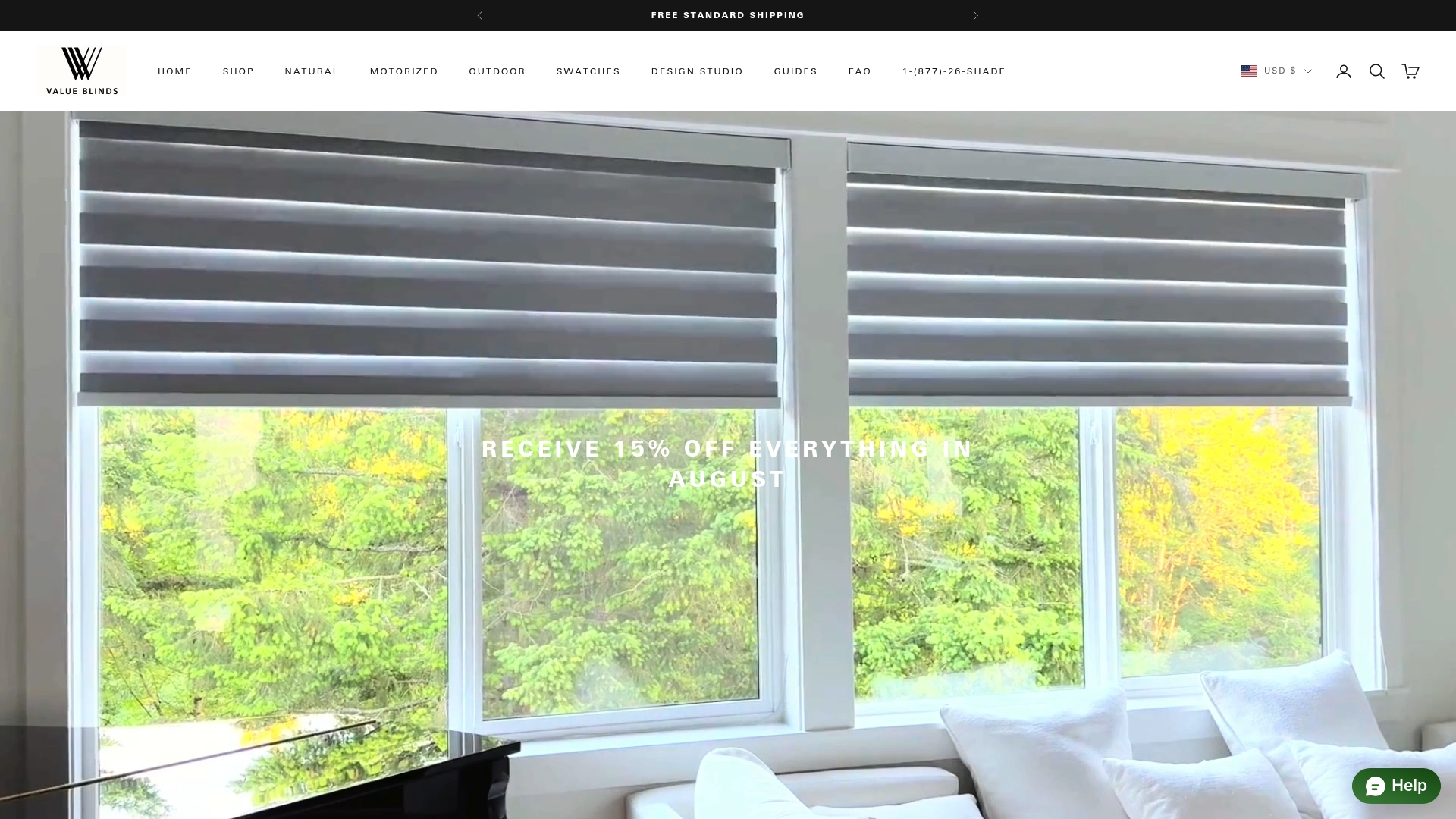
Now is your chance to bring your dream bedroom to life. Explore exclusive new options and tailored solutions at https://valueblindsdirect.com. Experience a smoother way to shop, get expert support, and enjoy premium products delivered to your door. Make your bedroom a true sleep sanctuary with Value Blinds today.
Frequently Asked Questions
What types of blinds are best for bedrooms?
When selecting blinds for bedrooms, consider options like Venetian blinds for precise light control, roller blinds for a sleek look, and cellular shades for energy efficiency and insulation. Each type offers unique advantages in light management and aesthetics.
How do blinds impact sleep quality?
Blinds play a crucial role in light management, which is essential for maintaining optimal sleep environments. Effective light blocking can minimize nighttime awakenings and support healthy circadian rhythms, ultimately improving sleep quality.
What materials should I choose for bedroom blinds?
For bedroom blinds, materials like wood offer durability and insulation, while fabric options like cellular shades provide light filtering and energy efficiency. Synthetic materials are easy to maintain and resist allergens, making them practical for a sleeping environment.
How do I measure my windows for blinds correctly?
To measure for blinds, determine if you want an inside or outside mount. For inside mounts, measure the width and height at three points and use the narrowest measurement. For outside mounts, extend measurements beyond the window frame by 2-3 inches on each side for optimal coverage.


